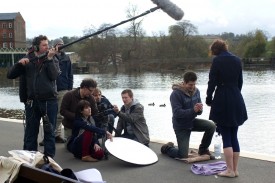
Like Janus I’m looking forwards and backwards today, the first anniversary of Stop/Eject‘s shoot beginning. First of all, here are a few key things I’ve learnt from making Stop/Eject:
- Pay people. It’s not worth the stress and hassle when unpaid cast and crew pull out at the last minute.
- Don’t do multiple jobs, even if you have the necessary skills. Delegate, collaborate, nurture the talents of others and save your own time so you can excel at the one thing you need to do.
- Get the script right before you shoot. I “learn” this with every film I do, and somehow forget it as soon as I get into preproduction on the next one.
- Directors shouldn’t edit their own films. It will be better if someone else cuts it. No exceptions. It’s as simple as that.
- Don’t shoot without a 1st AD, or at least a script supervisor. No director can keep all the important stuff in their head and run a shoot on schedule without help.
With the project drawing near to completion, my thoughts are turning towards my next films. As regular readers will know, writer Tommy Draper has been working on a feature-length version of Stop/Eject for some time.
However, I feel that trying to get a feature financed with me as director right now wouldn’t be much easier than it was a couple of years ago when I was trying to get The Dark Side of the Earth made. So I intend to make another short film first. It’s too early to reveal any details, but I can tell you that after advertising on Shooting People I’ve teamed up with a writer called Kevin O’Connor who is currently working on a third draft script based on a one-line idea of mine.
I’ll also be entering Virgin Media Shorts again this year, and my wife Katie is hard at work on a puppet for that. Intrigued? You ought to be.
Stay tuned for the latest news on all of these projects, and I’ll leave you with a reminder of what we were up to this time last year.
